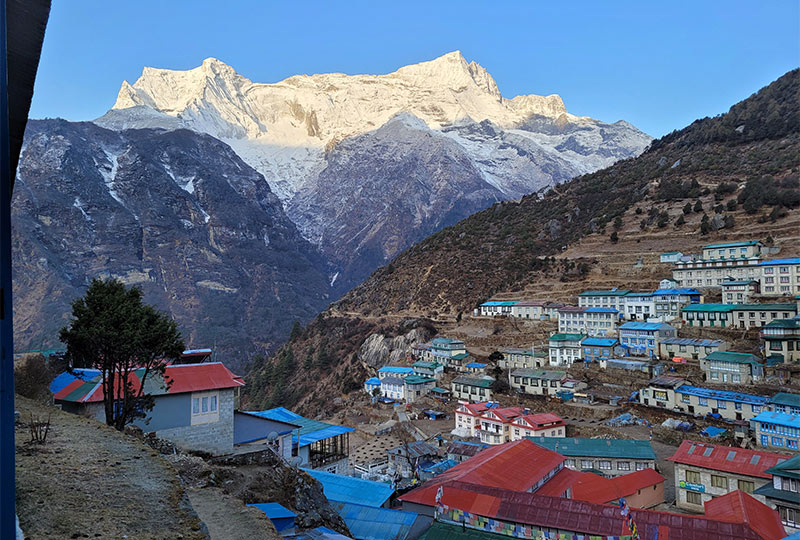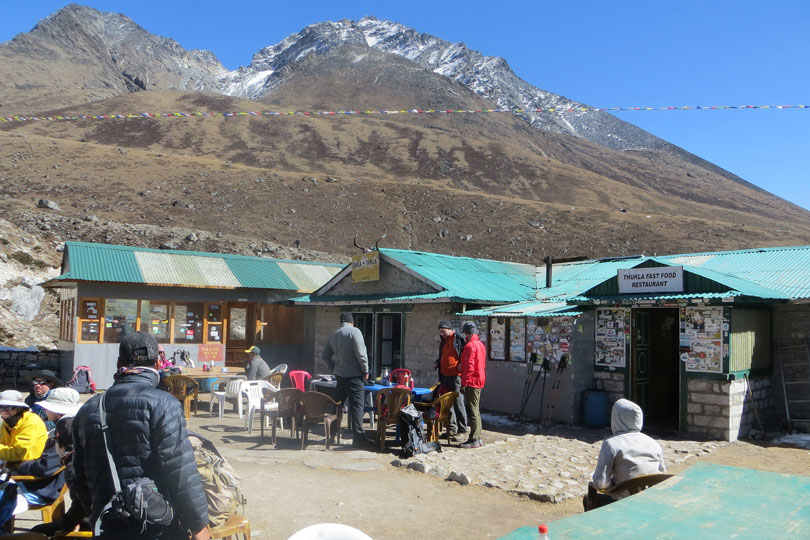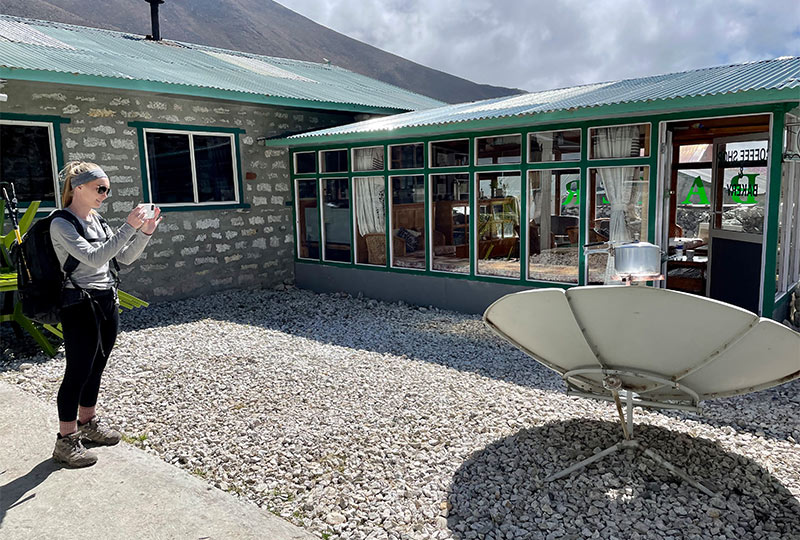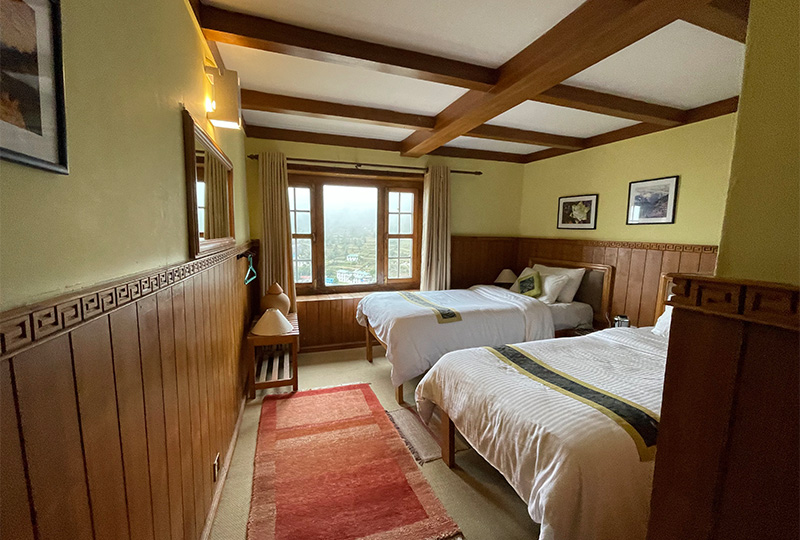In general, a teahouse is something more than what the name suggests. It is a stopover where trekkers stay overnight, have their food, and perhaps use other available services. Food on Everest Base Camp trek is more or less the same at most teahouses.

Perhaps, it was just a mere teahouse (with its literary meaning) where trekkers rested for a while and had their hot cup of tea.
In due course of time, the mode of accommodation reformed gradually from teahouses to lodges and hotels. And yet, these lodges or hotels are nowadays referred to as ‘teahouses’. The cost of food on Everest Base Camp trek varies with the altitude of the teahouse; higher the elevation, higher the price!
How did the tea house begin in Everest Region?
The story of the beginning of teahouses dates back to 1953. In reality, when Edmund Hillary led the first expedition to Mount Everest, there was not a single tea shop or tea house. Actually, every trekking and expedition in the Everest region had logistic crews for camping and kitchen.
During the early 1990s, the local villagers were encouraged to open tea shops. These tea shops would provide basic foods like hot beverages, Dal Bhat (Nepalese main course), fries, and crisps. Fortunately, the villagers realized the power of tourism to uplift their economy. In the late 1990s, the natives started adding value to their products. There was upgradation of rooms as well as food and services for warm hospitality in the Himalayas.
Now, you can get your favorite coffee (from mocha to latte) and your favorite food (may it be pizza, hamburger, or steak) at such remote corners of Nepal. Most European, American, Tibetan and Nepalese cuisine are available along the course. But as you climb higher, your choice to food option is limited. Surprisingly, you can spend nights in luxury lodges throughout your trek in the Himalayas.

What do teahouses offer?
In short, food to eat and place to sleep, is a teahouse. Obviously, it is a place to relax at the end of the trekking day. Luckily, you do not require to carry your camping gear. Normally, it’s a 5 to 7 hour-walk at daytime and rest the remaining time in the teahouse.
You are right if you think that a teahouse trek means hiking in the prominent areas of Nepal. For example, areas such as Everest, Annapurna, and Langtang. As altitude increases, the amenities in the teahouses change from standard to more basic. Nonetheless, it is only a teahouse trek that will allow you to explore and experience the Nepal Himalayas.
What actually is a “teahouse trekking”?
As said earlier, a teahouse trek is hiking during daytime and sleeping at the teahouse. Usually, a teahouse is a lodge or a small hotel to spend the night. It is one of the most popular styles of trekking in Nepal among both locals and foreigners. However, forget the teahouses if you are wishing to do an off-the-beaten-trek in Nepal, such as Tsum Valley Trek, Manaslu Circuit Trek, or Kanchenjunga Circuit Trek.
On a teahouse trek, you will go from one teahouse to another for your food and accommodation needs. In the past, it was supposedly a place where trekkers got basic refreshments like tea, local food and accommodation. But, with the gradual passage of time the concept of teahouses has changed.

Nowadays, teahouses are small hotels or lodges established along the trekking routes. They provide room and board at a nominal price. Usually, the local people own and run the teahouses. They are great places to interact with the locals, experience the local hospitality and diverse culture.
As the name suggests, teahouses offer tea during all meals. Usually, it is milk tea, which is the norm. However, depending on the trekking route, you will get black tea flavored with mint, ginger, lemon etc. Although coffee may be available, decaffeinated ones are really hard to find at these altitudes. If you are a coffee lover, then we recommend bringing your own brand of coffee. Another option is buying it in Kathmandu before leaving for the trip.
There is a plus point of going on a teahouse trek if you’re going in the Everest region. And, that is, you don’t have to worry about carrying your own food and trekking equipment. Even if you wish to stay overnight at Everest base camp, a teahouse trek is the best way to do it, except that you will need to sleep in a tent at the base camp.
A teahouse trek usually involves the following:
- Trekking for at least 5 to 7 hours in a day
- Sleeping at the teahouses/lodges during the night time
- Walking through rugged landscapes along the routes
- Enjoying dauntless mountains
- Exploring the wilderness of the Himalayas
Since lodges or hotels are sometimes referred to as teahouses, this trek is also often called the Everest lodge-to-lodge trek.
Interesting things about teahouse trekking in Nepal
- Unlike camping trek, everything including food, accommodation, and required equipment will be organized by your agency.
- Neat and clean rooms will be provided on twin sharing basis.
- Hot water may not be available at all places, or you may need to pay an extra charge for it.
- Food in local teahouses are fresh and hygienic, however, you may not have many choices.
- Electricity is usually available in the main dining area at an hourly rate at teahouses in higher altitudes.
- Most teahouses have a central plug point in the communal area.
- Mobile connectivity is good, and the prices are affordable at most teahouses, but internet connectivity is not always available.
- You need to pay a meagre amount to use the WiFi service in some teahouses where internet is available.
- You may need to pay an extra charge to recharge batteries on your electronic devices at teahouses.
- Hot showers come at an extra cost in the teahouses.
- Toilets in the teahouses are not very glamorous. Teahouses at some places have en-suite bathrooms and western toilets. But, at most places they are a shared facility with traditional squat toilets.
Teahouse Trekking in the Everest Region
The teahouses on Everest base camp trek will serve you food, accommodation and other required amenities while trekking in Nepal. While you are on an Everest teahouse trek, you won’t have to worry about regular meals or carrying hiking food. However, your choices are limited, in terms of variety.

Mt. Everest is the most echoed story of thousands of traveling souls in the world since 1953. A true traveler ventures in the Everest region at least once in their lifetime. Else, it definitely must be on their bucket list.
Indeed, the Everest Base Camp is the most popular trekking destination in the world. The history says it all; the most traveled path of the world is none other than the trail to Everest. Far from the reach of luxury and convenience, the mountains in the Himalayas, with its beauty, adds obsession to the travelers.
The Everest region trekking facts
During your Everest teahouse trek, your hiking altitudes will vary from 2,860m (9,383ft.) to 5,545m (18,192ft.). Relishing a picturesque moment in Kala Patthar, the highest point of this trek will allow you to enjoy the ground-breaking experience.
The mesmerizing trek to Namche, Tengboche, Dingboche, Lobuche and Everest base camp is no less astounding than the scenic flight from Kathmandu to Lukla and back. And also, the Sherpa culture in the Khumbu region will immerse you in their unique culture and traditions.
Teahouse facilities at Lukla
Lukla is the place where your airplane will drop you to begin the trek. And yes, it is also the place where you will spend your last night in the Everest region on trek completion. For obvious reasons, Lukla is usually known as the gateway to the Everest region.

Room accommodation in the teahouses at Lukla are standard, comfortable and clean. Nevertheless, we will make sure to provide you the best available lodge at the time of your arrival. Food will be served to you from your menu choice, anything except alcoholic beverage that you wish to try. Some teahouses at Lukla are Hotel Sunny Garden, The Nest, Khumbu Resort, and Buddha Lodge.
Teahouse facilities at Phakding
On arrival at Lukla, you will begin trekking to reach Phakding and stop there. Moderate room accommodations are well managed in Phakding standard teahouses. For your information, you can bring your own bed liner if you wish to, or if you are a little concerned about cleanliness. Blankets will also be available for you. You have the liberty to choose your food from the teahouse menu for dinner as well as breakfast.

Don’t forget to carry your ear plugs as the walls between rooms are thin and the voices from the other room may disturb your sleep at night. Some teahouses at Phakding are Hotel Snowland, Kala Patthar Lodge, Hotel Beer Garden, and Hotel Mountain.
Teahouse facilities at Namche Bazaar
Namche Bazaar is a place where you will be sleeping for two nights before trekking further, and also one night when you return. There are plenty of teahouses, lodges, small hotels, as well as luxury resorts here, being the largest Sherpa town of the entire Khumbu region. Almost all trekkers and climbers spend few days here for the purpose of acclimatization.

Standard teahouses and hotels in Namche Bazaar are mostly simple stone and wooden buildings, but recently many concrete buildings have come up. All essential amenities will be provided at the teahouse or the lodge that you stay. You can eat food of your choice from the menu provided by the teahouse. Some of the popular teahouses in Namche are Hotel Hilton, Hotel Sherpaland, Hotel Green Tara, and Namche Guest House.
Teahouse facilities at Tengboche
Tengboche is a serene village that houses the renowned monasteries in the Khumbu region while resting on the lap of the sacred Mt. Khumbila. The unrivaled backdrop of Mt. Ama Dablam is simply awe-inspiring. Tengboche is probably the most common night halt after Namche Bazaar for trekkers in this region.
Most trekkers visit the Tengboche Monastery during their trek to Everest base camp. It is the center of Nyingmapa Buddhism in Khumbu and lies very close to your teahouse. You can easily spend an hour or two at the monastery.

Standard teahouses and lodging accommodation in Tengboche are simple stone and wooden buildings or even huts with a kitchen, a common dining hall and bathroom area. The room usually includes a single-sized bed with a sheet, pillow, and blanket, and of course a bedside table and ceiling light. The most popular teahouses in Tengboche are Hotel Himalayan, Tengboche Guest House, and Hotel Tashi Delek.
Teahouse facilities at Dingboche
Dingboche lies at an elevation of 4,360 meters (14,304ft.) above sea level and has a limited number of teahouses. If you are traveling solo, then it is likely for you not to get a room to sleep during the peak trekking season unless you book the room earlier. Dingboche is yet another place to get further acclimatized and most trekkers usually spend an extra night here.

Standard teahouses and small lodges in Dingboche are simple stone and wooden building or huts with a kitchen, a common dining room and a bathroom area. The wall between each room is quite thin and your bed seems to be a bit hard. You will be provided with a pillow and a blanket. We recommend a good quality sleeping bag above this place. Note that not all teahouses present at this location has an attached bathroom.
Teahouse facilities at Dughla
Dughla is a small hamlet consisting of several huts and is located at an altitude of 4,600 meters (15,093ft.) above sea level. Most trekkers skip this place and continue walking further up to Lobuche, walking that extra hours. Until a couple of years back, there have been only two teahouses in Dughla.

The teahouses in Dughla are Yak Lodge and Kala Patthar Lodge. They are simple and very basic with a kitchen, a common dining hall, and a bathroom area. the beds feel harder and the walls between rooms thinner. You will have a similar blanket and a pillow, but without a sleeping bag, you will definitely feel the cold kicks at night.
Teahouse facilities at Lobuche
Lobuche is a busy place during the peak seasons as hundreds of trekkers, porters and Sherpas will pass through this village. As you get higher, the number of accommodation options decrease and also gets more and more basic. Here at Lobuche the lodging accommodation is extremely primitive.

Teahouses in Lobuche consists mostly of stone huts with shared bunk dormitories although a few modern lodges have come up in the recent past. Amenities and room facilities are obviously inferior as compared to the teahouses at lower regions. You feel more cold at night and the bed seems to get harder.
These teahouses have squatty toilets, a communal dining room, and a common fireplace. Each room here has two or more beds. Some teahouses do have western-style toilets, but they are not feasible during the winters.
The most popular teahouses in Lobuche are Himalayan Eco Lodge, Oxygen Home, Hotel Mother Earth, and New EBC Guest House
Teahouse facilities at Gorak Shep
Gorak Shep is the last place in the Everest region where a trekker gets to sleep unless you book a Sleeping overnight at Everest base camp trek with us. Here, you will find only a few teahouses and all of them mostly crowded during the peak seasons. Every trekker going to the base camp is bound to stay overnight at Gorak Shep, making it quite crowded. Although teahouses are simple and basic, you can find only one or two standard teahouses at Gokyo, with or without attached bathrooms.

The very few teahouses in Gorak Shep are again stone and wooden buildings, and some with recently built cement constructions. The rooms are very elementary and choice of food may not be as diverse as at lower elevations. The most popular teahouses at Gorak Shep are Buddha Lodge, Yeti Resort, Himalayan Lodge, and Everest Inn.
Teahouse facilities at Pheriche
Pheriche is obviously a very popular stop for trekkers and climbers. The Himalayan Rescue Association operates here in this village. There are quite a number of teahouses, hotels and lodges scattered around. Many trekkers stop here on their way back from the Everest base camp while some skip and walk until the next destination.

Teahouses in Pheriche are well managed, clean and much more comfortable than the previous days. Apart from basic teahouses, you will find few standard teahouses and lodges with attached bathroom in Pheriche. Some have hot-shower facilities and western-style flush toilets. There is a lot of food option for you choose from their menu. Some of the most popular teahouses in Pheriche are Himalayan Hotel, The White Yak Mountain Hut, Snowland Lodge, and Panama Eco Lodge.
What kind of teahouse accommodation can you expect in popular treks in Nepal?
| Everest Base Camp Luxury Lodge Trek | Luxury teahouse accommodations |
| Everest Base Camp Trek via Gokyo Lakes and Cho La Pass – 18 Days | Wide variety of teahouse accommodations |
| Annapurna Circuit Trek – 21 Days | Wide variety of teahouse accommodations |
| Annapurna Base Camp Trek – 11 Days | Wide variety of teahouse accommodations |
| Around Manaslu Trek – 18 Days | Reasonable variety of teahouse accommodations |
| Tsum Valley Trek – 19 Days | Home stay/Guesthouses accommodations |
| Khopra Ridge Community Trek – 13 Days | Few Community Lodge, private lodges and teahouse accommodations |
What types of foods can I expect on an Everest trek?
So are you excited about Everest teahouse trekking in Nepal? No doubt it’s a wonderful thing that you will have a treat of a lifetime! Although the feeling of novelty and excitement is there, you are still a bit concerned about your dietary expectations found in these mountain lodges high up in the Himalayas.
Perhaps you are little worried about the food. Needless to say, but the importance of a well-balanced diet cannot be overemphasized during your trip. Well, here’s an overview of a typical Nepalese teahouse menu in the Everest region, and if you are on a camping trip, this will certainly serve as a handy guide.

Teahouses on more popular trekking routes in Nepal like Everest and Annapurna regions offer a wide range of western and local delicacies that include Nepali, Indian, Tibetan, and Chinese varieties. Everyone eats in a common dining room, which normally houses a wood fire. You could experience some local alcoholic brew to keep you warm in the evening time, although we do not recommend consuming any form of alcoholic beverage at high altitudes.
You will enjoy 3 hearty meals each day. Lunch will be served at teahouses or small restaurants along the trail. Breakfast and dinner will be provided at the lodge you will be staying at the end of the day’s hike.
The chefs at most teahouses are trained in hygienic food preparation. If needed, vegetarian, vegan, gluten-free, and kosher diets can be organized with prior notice.
Typical breakfast in the Everest teahouse/lodge:
- Beverage: black tea, milk tea, ginger lemon honey tea, lemon tea, hot lemon with honey, black coffee, milk coffee, hot chocolate
- Toast with jam or honey, toast omelet, pancake, Tibetan bread, porridge/ muesli
- Eggs on your choices
- American breakfast or Continental breakfast
Typical lunch in the Everest teahouse/lodge:
- Rice item: veg fried rice, egg fried rice, mixed fried rice, dal-bhaat
- Noodle item: vegetable fried noodle, mixed fried noodle
- Potato item: chips, fried potato, hash brown potato, veg fried potato, boiled potato
- Burger: veg burger, chicken burger, veg sandwich, chicken sandwich
- Pasta: spaghetti tomato sauce, macaroni cheese sauce
- Pizza: veg pizza, tomato cheese pizza, chicken pizza, mushroom pizza
- Momo (Nepali style dumplings): veg momo, chicken momo
- Meat item: chicken sizzler, chicken steak, yak steak
- Beverage: black tea, milk tea, ginger lemon honey tea, lemon tea, hot lemon with honey, black coffee, milk coffee, hot chocolate
Typical dinner in Everest in the Everest teahouse/lodge:
Soups:
- Vegetable soup
- Mushroom soup
- Chicken soup
- Chicken noodle soup
- French onion soup
- Pumpkin soup, potato soup
Main Meals
- Rice item: veg fried rice, egg fried rice, mixed fried rice, dal-bhaat
- Noodle item: vegetable fried noodle, mixed fried noodle
- Potato item: chips, fried potato, hash brown potato, veg fried potato, boiled potato
- Burger: veg burger, chicken burger, veg sandwich, chicken sandwich
- Pasta: spaghetti tomato sauce, macaroni cheese sauce
- Pizza: veg pizza, tomato cheese pizza, chicken pizza, mushroom pizza
- Momo (Nepali Dumplings): veg momo, chicken momo
- Meat item: chicken sizzler, chicken stake, yak steak
- Dessert: apple pie, chocolate cake, carrot cake, apple fritter, canned fruit
- Beverage: black tea, milk tea, ginger lemon honey tea, lemon tea, hot lemon with honey, black coffee, milk coffee, hot chocolate
Meat products either have to be flown in or have to be carried by porters or on the back of yaks and donkeys to the mountain regions. So, don’t expect meat and meat-products to be fresh, at least above Namche Bazaar. We recommend all our clients to refrain from meat items to avoid falling sick while on the trek. And, remember, the price of meat items gets expensive the higher you go! Instead, carrying your own canned meat from Namche Bazaar is a winning bet.
Electricity and WiFi in Everest Teahouses
Teahouses in the Everest region use solar channels as sources of electricity and most of the teahouses have WiFi and charging outlets. When you begin ascending, the price for charging increases from free to quite a substantial amount. We recommend you to carry your own power backup (power banks).
There are no WiFi hotspots, especially along the trails after Namche in the Everest trekking region. At high elevations at all trekking regions in Nepal, you will need to pay for using internet services, which increases gradually with the altitude.
There are only a few places in the Everest trekking trail where you will be devoid of internet and WiFi services. However, if you have a local SIM card with you, then it is possible that you could still browse the internet, except at some places although the internet services may be dead slow.
What types of lodges do Himalayan Glacier provide to their clients on an Everest teahouse trek?
You need not worry about the types of lodges that we provide to our clients. We provide the best available standard lodges that are absolutely clean and have decent rooms at all viable places, unless you wish for more luxurious accommodation. Most teahouses and lodges are facilitated with basic amenities.
Houses are basically two-story with thatched roof except for luxury lodges and restaurants. Rooms are primarily filled with a wooden bed, a thick blanket, and a pillow. Your room will have attached bathroom until Dingboche, but if you manage to arrive early at your next destination above Dingboche or your guide books a room much earlier, then you might get rooms with attached bathroom even at places above Dingboche. But, obviously the room tariff will be on a bit higher side than normal rooms.

We recommend you bringing your own sleeping bag, else Himalayan Glacier will provide you one, which you need to return after the trip. Walls of the teahouses are pretty thin. You can hear others talk in the other rooms, so don’t forget bring your ear plugs!
Just one thing to remember is that, as you go higher the services will become more limited in the teahouses with fewer options to choose with what to eat.
Conclusion
All you need to know is that most teahouses or small lodges will provide all the basic amenities for a comfortable trekking experience in the Himalayas. Right from a single bed and hot meals to hot shower and some other basic services, the teahouses in the Everest region have them all.
More than drinking tea, eating and sleeping, a teahouse means a place to get an amazing insight into the local culture. Having said that, an Everest teahouse trek is a fantastic way to experience and explore the best of Nepal Himalayas.
Do not miss to see the other side of Nepal. Most visitors do not get to see the other side, when they are trekking in the Everest trails.






